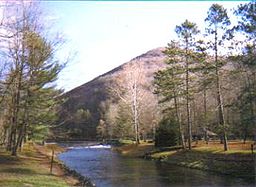Ole Bull State Park
| Ole Bull State Park | |
| Pennsylvania State Park | |
|
Kettle Creek flowing through Ole Bull State Park
|
|
| Named for: Ole Borneman Bull | |
| Country | United States |
|---|---|
| State | Pennsylvania |
| County | Potter |
| Township | Stewardson |
| Location | |
| - elevation | 1,417 ft (432 m) |
| - coordinates | 41°32′10″N 77°42′44″W / 41.53611°N 77.71222°WCoordinates: 41°32′10″N 77°42′44″W / 41.53611°N 77.71222°W |
| Area | 132 acres (53 ha) |
| Founded | 1925 |
| Management | Pennsylvania Department of Conservation and Natural Resources |
| IUCN category | III - Natural Monument |
| Website: Ole Bull State Park | |
Ole Bull State Park is a 132-acre (53 ha) Pennsylvania state park in Stewardson Township, Potter County, Pennsylvania in the United States. The park is located on Pennsylvania Route 144, 26 miles (42 km) north of Renovo and 18 miles (29 km) south of Galeton. Ole Bull State Park is in the Kettle Creek Valley, and is surrounded by Susquehannock State Forest. The woods surrounding the park are called the Black Forest because of its once dense tree cover.
Ole Bull State Park is named for Ole Borneman Bull. Ole Bull was a famous Norwegian violinist. He visited the United States several times and played with great success. While visiting the United States, Bull became interested in founding a colony for his fellow countrymen. In 1852, he purchased 120,000 acres (49,000 ha) of land for $10,000 in Pennsylvania and founded the colony, which was called New Norway. He established four communities, New Bergen (now known as Carter Camp), Oleana, New Norway and Valhalla in the Kettle Creek area. Ole Bull began work on a "castle", which he named Nordjenskald. The castle and the communities were abandoned in less than a year. The problems encountered by the Norwegian pioneers were mainly based on the inexperience of the farmers in dealing with clearing the land of its many trees. The Norwegians, however, did not give up. They migrated west into Minnesota and the Dakotas. The settlement may have failed, but Ole Bull was not forgotten. The citizens of Norway paid for the construction of a monument to honor Ole Bull. The statue was placed in the park on the 150th anniversary of New Norway in 2002.
The Kettle Creek area was part of the massive lumbering operation that occurred in most of north central Pennsylvania in the 1880s and 1890s. The lumbering industry harvested the old-growth white pine and hemlock. Two railroads were built on the banks of Kettle Creek to haul the timber to sawmills in the Cross Fork area. The old-growth forest was soon gone. The land was no longer useful to the lumber industry and it fell into disuse. The Commonwealth of Pennsylvania purchased much of the land and Ole Bull State Park was opened in 1925.
...
Wikipedia


